国际交流英语视听说B3U6
- 格式:ppt
- 大小:37.72 MB
- 文档页数:172
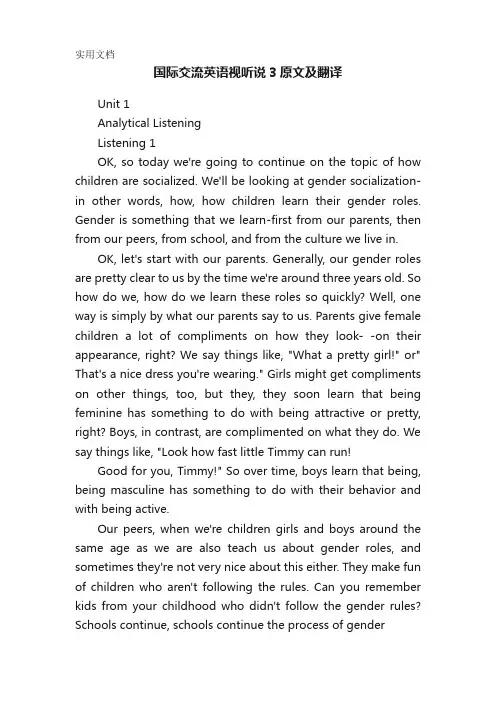
国际交流英语视听说3原文及翻译Unit 1Analytical ListeningListening 1OK, so today we're going to continue on the topic of how children are socialized. We'll be looking at gender socialization-in other words, how, how children learn their gender roles. Gender is something that we learn-first from our parents, then from our peers, from school, and from the culture we live in.OK, let's start with our parents. Generally, our gender roles are pretty clear to us by the time we're around three years old. So how do we, how do we learn these roles so quickly? Well, one way is simply by what our parents say to us. Parents give female children a lot of compliments on how they look- -on their appearance, right? We say things like, "What a pretty girl!" or" That's a nice dress you're wearing." Girls might get compliments on other things, too, but they, they soon learn that being feminine has something to do with being attractive or pretty, right? Boys, in contrast, are complimented on what they do. We say things like, "Look how fast little Timmy can run!Good for you, Timmy!" So over time, boys learn that being, being masculine has something to do with their behavior and with being active.Our peers, when we're children girls and boys around the same age as we are also teach us about gender roles, and sometimes they're not very nice about this either. They make fun of children who aren't following the rules. Can you remember kids from your childhood who didn't follow the gender rules? Schools continue, schools continue the process of gender好的,今天我们将继续关于儿童如何社交的话题。
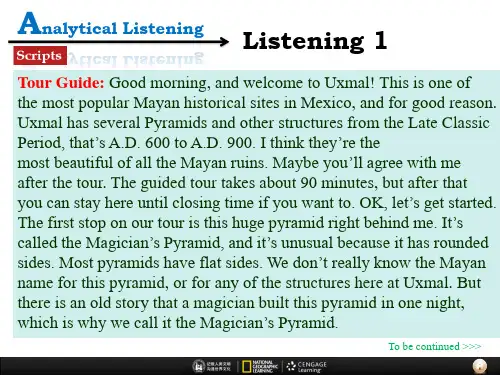
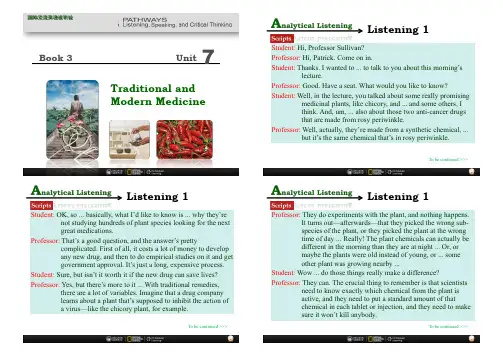
Unit7Traditional and Modern MedicineBook 3Student: Hi, Professor Sullivan? Professor: Hi, Patrick. Come on in.Student: Thanks. I wanted to ... to talk to you about this morning’slecture.Professor: Good. Have a seat. What would you like to know?Student: Well, in the lecture, you talked about some really promisingmedicinal plants, like chicory, and ... and some others, I think. And, um, ... also about those two anti-cancer drugs that are made from rosy periwinkle.Professor: Well, actually, they’re made from a synthetic chemical, ...but it’s the same chemical that’s in rosy periwinkle.To be continued >>>Listening 1Student: OK, so ... basically, what I’d like to know is ... why they’renot studying hundreds of plant species looking for the next great medications.Professor: That’s a good question, and the answer’s prettycomplicated. First of all, it costs a lot of money to develop any new drug, and then to do empirical studies on it and get government approval. It’s just a long, expensive process.Student: Sure, but isn’t it worth it if the new drug can save lives? Professor: Yes, but there’s more to it ... With traditional remedies,there are a lot of variables. Imagine that a drug company learns about a plant that’s supposed to inhibit the action of a virus—like the chicory plant, for example.To be continued >>>Listening 1Professor: They do experiments with the plant, and nothing happens.It turns out—afterwards—that they picked the wrong sub-species of the plant, or they picked the plant at the wrong time of day ... Really! The plant chemicals can actually be different in the morning than they are at night ... Or, or maybe the plants were old instead of young, or ... some other plant was growing nearby ...Student: Wow ... do those things really make a difference?Professor: They can. The crucial thing to remember is that scientistsneed to know exactly which chemical from the plant is active, and they need to put a standard amount of thatchemical in each tablet or injection, and they need to make sure it won’t kill anybody.To be continued >>>Listening 1Student: Can medicines actually kill people?Professor: It’s possible ... That’s why they have studies to find outwhat the medicines will do ... They might start with rats and mice, but eventually, they need to do large clinical trials with human beings.Student: That makes sense. And are those clinical trials expensive? Professor: Absolutely, and they take time, too.Student: Well, I guess I can understand the problem, then. It’s ashame though ... with plant species going extinct and all, I mean, one of those plants could ... might be the cure for some disease, and we’ll never know about it.Professor: You could be right.To be continued >>>Listening 1Student: Well, I need to get to the library. Thanks for taking the timeto talk to me.Professor: No problem at all ... Anytime. See you in class.Listening 1Teresa: Did I tell you my father is having a hip replacement nextweek?Aiden: No, what’s the matter with his hip?Teresa: He has a lot of pain in his hip—from arthritis. It must behereditary because everyone in my family gets arthritis when they get older.Aiden: Yeah, it’s very common—unfortunately, ... but isn’t hipreplacement a pretty radical surgery?Teresa: No, not really ... I mean, it’s major surgery, but it’s fairlysimple and it’s over in a few hours.Aiden: I see. So what does the surgery consist of? What do they haveto do?To be continued >>>Listening 2Teresa: Well, they remove part of the bone at the top of the leg, andthey put in a, a device—a metal device. It has a ball and ... a socket, just like a real hip joint.Aiden: Hmm ... And then how long is the recovery? Will, will yourdad be in a lot of pain?Teresa: He’ll be in a hospital for a few days, and then he needsphysical therapy for six weeks to make the leg muscles strong again. There will be some pain, but it shouldn’t be too severe. Aiden: That’s good.Teresa: Definitely, but even when something is wrong, my dad tendsto pretend that everything is fine ... If he is in pain, I’ll never know about it.To be continued >>>Listening 2Aiden: My father is the same way.Teresa: The extraordinary thing is ... after the surgery and therecovery, the hip will be as good as new. He’ll need to be careful, of course, but he’ll be able to take walks, or travel, or whatever.Aiden: That’s great. I hope it goes well for him. Teresa: Thanks.Listening 2Narrator: Have the sniffles? Feeling under the weather? Have an acheor a pain? Then generally, our first stop is the drugstore. But this luxury is only allowed to humans. It may not surprise you to learn that the rest of the species that inhabit the planet come up with some very interesting ways of self-medication. Deep in the English countryside, animal behaviorist Cindy Engel studies a new form of biology called zoopharmacognosy—or animal self-medication. Cindy’s dedicated the last few years of her life into compiling all of her research into a new book.To be continued >>>Cindy Engel, Animal Behaviorist: I often have people asking mewhether it’s just instinct , and … and the answer is, is, is no —you know, I mean the, the ability to seek out a well balanced diet is incredibly complicated, and they are adjusting it moment to moment . Narrator: Engel suggests there may be examples where humans,having studied animals’ self-medicating, have come across benefits ourselves in drugs or chemical uses. Cindy Engel: Early medicine was based on observing the behavior ofsick animals. It’s relatively recently that we’ve stoppedlooking. Chimpanzees have already shown six or seven new compounds previously unknown to science , many of which are incredibly important for human medicine.To be continued >>>Narrator: Engel’s book has received enormous interest in scientificcommunities across Europe and North America. She’sconcentrated on three main areas of animal self-medication. First are curative measures, whereby animals have theability to cure contracted ailments. Second are preventative measures, whereby animals take positive action to protect themselves from illness or parasites. And lastly areavoidance measures, where animals have the knowledge or insight to avoid toxic plants and select the right food to keep themselves on a healthy diet. Cows, for instance, have certain ways of improving their self-health.To be continued >>>Cindy Engel: Cattle have got a special type of stomach—they have toferment, the, the tough fibrous material in the grass. And fermentation requires a really carefully-balanced level of acidity, and clay will, being, being alkaline, will help balance acidity for the fermentation process. Narrator:And this is not an unconsidered part of the cow’s ecologyand behavior. Some species will travel long distances just to get to the right type of dirt.Cindy Engel: Wildebeests, in, in Africa, are probably the bestexample. They will migrate to the volcanic ash floor. It contains these essential minerals for lactation.To be continued >>>Narrator: Observing wild animals self-medicating is something that’svery rarely seen, but during Engel’s research she came across some groundbreaking video footage. Cindy Engel: This snow leopard was being treated for a bladderinfection . She lives in San Francisco Zoo, and she had to go on a course of antibiotics, and antibiotics can cause nausea, and all the while she was suffering from nausea, she was eating grass continuously. And of course, when the antibiotics stopped, so did the grass eating.To be continued >>>Narrator: So, in an attempt to combat the effects of this man-madeantibiotic, this wild animal has resorted to self-medication by way of a good dose of grass. Whether it is buffalo eating mud to combat parasites or primates using plants to eliminate stomach infections , animal self-medication, or zoopharmacognosy is an area of biology that’s sure to attract much more attention in years to come .Using plants as natural remedies for health problems is nothing new. In fact, almost two-thirds of the earth’s population still rely on the healing power of plants. For them, nothing else is affordable or available. Plant-based medicine has also captured the attention of many scientists, who are studying plants’ ability to restore health and fight diseases such as cancer.In India, where many people talk about their symptoms with a traditional healer instead of a medical doctor, Darshan Shankar has created the Foundation for Revitalisation of Local Health Traditions. He says that preserving the knowledge of these healers is as crucial as conserving the plants they use. “The world has realized it should be concerned about saving biodiversity. But cultural knowledge is just as important.”To be continued >>>Listening 1Nat Quansah, an ethnobotanist who lives in Madagascar, studies plants such as the rosy periwinkle. A synthetic version of the active chemical from that plant is now produced in laboratories and made into drugs that inhibit cancer growth. Quansah knows abouthundreds of other promising plant species that could be the basis for future medicines.Jim Duke, now retired from the U.S. Department of Agriculture, still teaches and writes about medicinal plants such as chicory, which contains chicoric acid—a chemical that may someday be used to fight a deadly virus. Duke says that empirical studies of medicinal plants are needed. “We can use science to test plants, tofind what works best. The issue is how to use science to get the best medicine, be it natural or synthetic.”Listening 1As a child in Mozambique’s Niassa Province, Feliciano dos Santos caught the polio virus from the dirty water in his tiny village. “When I was young,” he recalls. “I never believed I would grow up, get married, have children, drive a car, and live such a full life ... ”These days, Santos and his band Massukos use music to spread messages of sanitation and hygiene to some of the poorest, most remote villages in Mozambique. Their hit song, Wash Your Hands, is part of a public health campaign created by Santos’ non-governmental organization (NGO), Estamos. The project hassuccessfully convinced villagers to install thousands of sustainable EcoSan latrines, dramatically improving sanitation and reducing disease throughout the region.Listening 2To be continued >>>Santos’ NGO also works on programs to install pumps for clean water, conduct health studies, and combat a new cholera epidemic. Says Santos, “Clean water is a basic human right, yet so many don’t have it. I’m using my music to be the voice of people who have no voice.Listening 2Imagine visiting your doctor for an annual exam—only this time the checkup consists of a routine DNA test. Using information from the test, your doctor not only predicts the hereditary health problems you’re likely to have in the future without having to ask about your personal history, but also selects the best medications for you. Although people tend to think of genetic mapping as very expensive and time-consuming, scientists can do genotyping—assessing one specific part of the genetic information—rather than reading a person’s entire genome. Since genotyping can be done quickly and inexpensively, it’s an extraordinary tool for assessing a patient’s risk factors.Listening 3Imagine visiting your doctor for an annual exam—only this time the checkup consists of a routine DNA test. Using information from the test, your doctor not only predicts the hereditary health problems you’re likely to have in the future without having to ask about your personal history, but also selects the best medications for you. Although people tend to think of genetic mapping as very expensive and time-consuming, scientists can do genotyping—assessing one specific part of the genetic information—rather than reading a person’s entire genome. Since genotyping can be done quickly and inexpensively, it’s an extraordinary tool for assessing a patient’s risk factors.Listening 3。
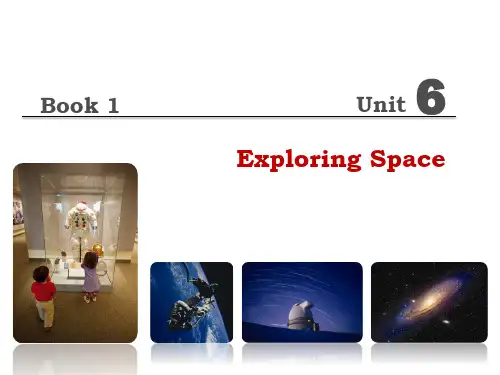
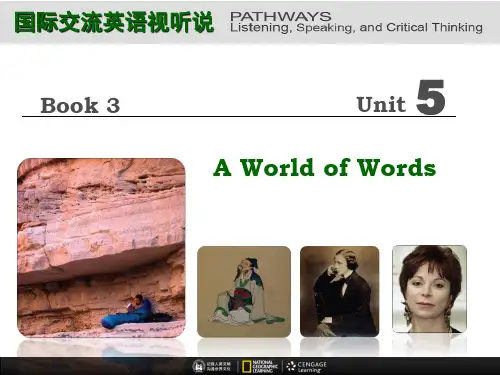
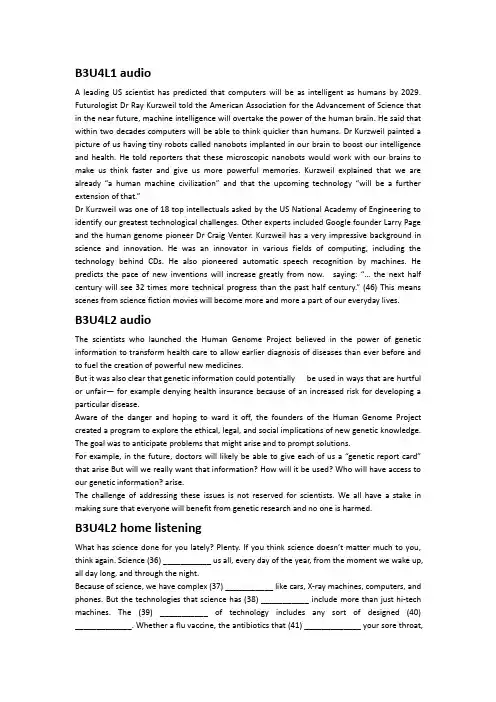
B3U4L1 audioA leading US scientist has predicted that computers will be as intelligent as humans by 2029. Futurologist Dr Ray Kurzweil told the American Association for the Advancement of Science that in the near future, machine intelligence will overtake the power of the human brain. He said that within two decades computers will be able to think quicker than humans. Dr Kurzweil painted a picture of us having tiny robots called nanobots implanted in our brain to boost our intelligence and health. He told reporters that these microscopic nanobots would work with our brains to make us think faster and give us more powerful memories. Kurzweil explained that we are already “a human machine civilization” and that the upcoming technology “will be a further exte nsion of that.”Dr Kurzweil was one of 18 top intellectuals asked by the US National Academy of Engineering to identify our greatest technological challenges. Other experts included Google founder Larry Page and the human genome pioneer Dr Craig Venter. Kurzweil has a very impressive background in science and innovation. He was an innovator in various fields of computing, including the technology behind CDs. He also pioneered automatic speech recognition by machines. He predicts the pace of new inventions w ill increase greatly from now. saying: “… the next half century will see 32 times more technical progress than the past half century.” (46) This means scenes from science fiction movies will become more and more a part of our everyday lives.B3U4L2 audioThe scientists who launched the Human Genome Project believed in the power of genetic information to transform health care to allow earlier diagnosis of diseases than ever before and to fuel the creation of powerful new medicines.But it was also clear that genetic information could potentially be used in ways that are hurtful or unfair— for example denying health insurance because of an increased risk for developing a particular disease.Aware of the danger and hoping to ward it off, the founders of the Human Genome Project created a program to explore the ethical, legal, and social implications of new genetic knowledge. The goal was to anticipate problems that might arise and to prompt solutions.For example, in the future, doctors will likely be able to give each of us a “genetic report card” that arise But will we really want that information? How will it be used? Who will have access to our genetic information? arise.The challenge of addressing these issues is not reserved for scientists. We all have a stake in making sure that everyone will benefit from genetic research and no one is harmed.B3U4L2 home listeningWhat has science done for you lately? Plenty. If you think science doesn’t matter much to you, think again. Science (36) ___________ us all, every day of the year, from the moment we wake up, all day long, and through the night.Because of science, we have complex (37) ___________ like cars, X-ray machines, computers, and phones. But the technologies that science has (38) ___________ include more than just hi-tech machines. The (39) ___________ of technology includes any sort of designed (40) _____________. Whether a flu vaccine, the antibiotics that (41) _____________ your sore throat,the technique and tools to (42) _____________ open heart surgery, or a new system of crop rotation, it’s all technology. Even simple things that one might easily take for (43) ___________ are, in fact, science-based technologies: (44) _____________________________________________________________________________, the plastic that makes up a sandwich bag, —it’s all here because of science. To make it clear how deeply science is interwoven with our lives, just try imagining a day without scientific progress.(45) _____________________________________________________________ (e.g., it’s hard to argue with the benefits of being able to effectively mend a broken bone), in some cases the payoffs are less clear-cut. It’s important to remember that (46) ____________________________________________________________________.36. affects 37. devices 38. inspired 39. notion40. innovation 41. treat 42. perform 43. granted44. the clean water that comes from your faucet, and the light that you turn off at the end of the day45. Though the impact of technology on our lives is often clearly positive46. science builds knowledge about the world, but that people decide how that knowledge should be usedB3U6L1 audioA solution may be at hand for holidaymakers who are finding it harder to get off the beaten track. For those who really want to get away from it all, a new holiday destination has sprung up —Antarctica. However, this new hotspot, or freezing zone, might only be for those with the deepest pockets if a new policy gets under way. Tourism on Antarctica has been increasing dramatically in the past twenty years, from a few thousand people in 1985 to more than 40,000 in 2007. The growing numbers are having a negative effect on the pristine environment of the South Pole. To combat this, researchers from Holland’s Maastri cht University have come up with a possible solution: limit the number of tourists allowed to visit and auction the vacations to the highest bidders.Many environmental protection agencies agree that there is a need to protect the frozen wilderness from the damage created by modern tourism. Antarctica is the last unspoiled place on Earth. It has a very delicate ecosystem that could be easily upset by hordes of tourists landing in airplanes and using skimobiles. A difficulty exists because Antarctica is not a country and therefore has no government to pass laws or guidelines to control the number of visitors. The Maastricht University team’s proposal to auction off a fixed number of tourist places seems a workable solution. It would limit the number of visitors and therefore contain the amount of environmental damage, and the money would be used to protect Antarctica’s future. B3U6L2 audioTraveling to World Heritage sites is rewarding! It is about exploring unique environments, engaging with cultural splendours, experiencing a different way of life and building lasting memories. The following are some great travel tips that canenhance your trip and benefit the World Heritage sites you visit. Here are the tips:Before traveling, first find out as much as possible. The more you know about a World Heritage site before arriving, the more the site will come alive. Second, pack light. It is tempting to pack everything you think you might need, but remember to be smart about your necessities. Packaging items like the paper box of your film or the plastic wrapping of your new toothbrush simply consumes space in your bag and can create excess trash for the World Heritage site. Finally, explore transportation options. Traveling affects the environment. Wherever possible, try to minimize your pollution and impact on the environment by looking to alternative transportation and off-setting your carbon emissions.During your traveling, tread lightly and respect the natural environment. These destinations are World Heritage sites because of their exceptional natural or cultural splendour. While it is important to support local economies, certain tourist activities and souvenirs can damage a fragile World Heritage site. Say “no” to souvenirs that are a piece of the site itse lf and to tourist activities that may be harmful to a site’s longevity.B3U6L2 home listeningWith nearly 1 billion tourists crisscrossing the globe every year, it’s more important than ever for travelers to minimize their individual (36) ___________ on th e earth’s natural and cultural treasures. The (37) ___________ negative effects of tourism are both local and global; oceanfront hotels (38) ___________ to beach erosion in Hawaii, rising numbers of visitors (39) ___________ the fragile ecosystems of the Galapagos Islands, and carbon dioxide (40) ___________ from planes are a growing contributor to global warming.Taking a green approach to travel is an easy and (41) ___________ way to protect the places you love to visit, not just for yourself but for the travelers who come after you and for the people who will continue to live there long after you’ve flown home. As an added bonus, it often makes for a more rewarding, (42) ___________ travel experience, encouraging deeper (43) ___________ with the people and places you visit.Contrary to popular belief, you don’t necessarily have to pay more in order to travel green. You can (44) _______________________________________________ ________________________________________. And Earth-friendly transportation options like biking, walking and taking public transit are often cheaper than taking a cab or renting a car. Also, you don’t need to sacrifice creature comforts or (45) _________________________________________________________________; you can visit big cities or small villages, and stay in small ecolodges or luxury hotels. All that’s required is (46) ___________________________________________________ _________________________________________ which means conserving plants, wildlife and other resources; respecting local cultures and ways of life; and contributing positively to local communities. It’s easier than you might think.36. impact 37. potential 38. contribute 39. threaten40. emissions 41. essential 42. authentic 43. connections44. find green lodging options in all budgets from hostels to luxury hotels.45. go off into the middle of nowhere to be a green traveler46. an effort to preserve and protect the natural and cultural environment of the place you’re visitingB3U7L1 audioAnyone who has experienced it knows all too well – video game addiction is real. Although gaming addiction is not yet officially recognized as a disorder by the American Medical Association, there is increasing evidence that people of all ages, especially teens and pre-teens, are facing very real, sometimes severe consequences associated with compulsive use of video and computer games.Video games are becoming increasingly complex, detailed and compelling to a growing international audience of players. With better graphics, more realistic characters and greater strategic challenges, it’s not surprising that some teens would rather play the latest video game than hang out with friends, play sports or even watch television.Of course, all gamers are not addicts – many teens can play video games a few hours a week, successfully balancing school activities, grades, friends and family obligations. But for some gaming has become an uncontrollable compulsion. Studies estimate that 10 percent to 15 percent of gamers exhibit signs that meet the World Health Organization’s criteria for addiction.. Just like gambling and other compulsive behaviors, teens can become so enthralled in the fantasy world of gaming that (46) they neglect their family, friends, work and school.B3U7L2 audioScriptInternet Addiction Disorder has long been recognized as a social problem.According to psychological counselor Li Jianling, if you have the following (36) symptoms, it is likely that Internet addiction has begun to infiltrate your life. Internet addicts lose track of time and spend less and less time on meals at home or at work. They are used to eating in front of a computer screen. Also, they deny spending too much time on the Net. They can’t help going online when already busy at work, and they sne ak online when family members aren’t at home, with a sense of (39) relief.It’s a commonly known fact that Internet addiction can have a devastating effect on peoples’ health and social lives. Adults may lose the most important years for their career development and students may waste too much of their (43) youth in front of a computer screen.But why is Internet addiction so prominent in China? Li Jianling explains that many youths are the only children in their families. They don’t have enough chances to associate with parents and relatives. Also, the lack of activities for adults can lead to Internet addiction. When people grow up,if they don’t spend time on sports or other positive interests, they often turn to theInternet to kill time.How do we deal with this problem? Li Jianling says (46) associating more with family, friends and nature can really help Internet addicts kick the habit.B3U7L2 home listeningResearch studies show that only 10–15% of gamers meet the criteria for addiction. Heavy game use is (36) ___________ by the American Medical Association as playing for more than two hours per day, yet (37) ___________ of the amount of time gamers spend playing video games (38) ___________ from 6 to 12 hours per week. In fact, reports typically suggest that gamers spend about a quarter of their (39) ___________ time playing video games.Considering this, it is easy to be (40) ___________ about whether your or someone else’s gaming falls in the (41) ___________ or heavy ranges.As with all addictions, it is important when considering the possibility of a video game addiction not simply to consider the amount of time spent gaming, but also the (42) ___________ it is serving the individual. Video game playing, as one of a range of (43) ___________ activities, may not be harmful or indicate an addiction. On the other hand, when game playing is addictive, it takes over as the person’s main way of coping with life, (44) ___________________________________________________ _________________________________.Video game addiction or video game overuse is seen most commonly in players of the persistent multiplayer gaming universe, or Massive Multiplayer Online Role Playing Game (MMORPG) , who make up 9.1% of gamers. These games (45) _____________________________________________________________________ ______________________. Research indicates that MMORPG players tend to be lonely, socially marginalized people who have difficulty with real life social interactions. They may feel that (46) _______________________________________ ____________________________________________________.36. symptoms 37. track 38. deny 39. relief40. commonly 41. social 42. career 43. youth44. with other important areas of life being neglected or disrupted as a result.45. hold many attractions for gamers – they are interactive, social, competitive and happen in real time.46. they have a more positive social experience and more control in virtual relationships than they do in the real world.。
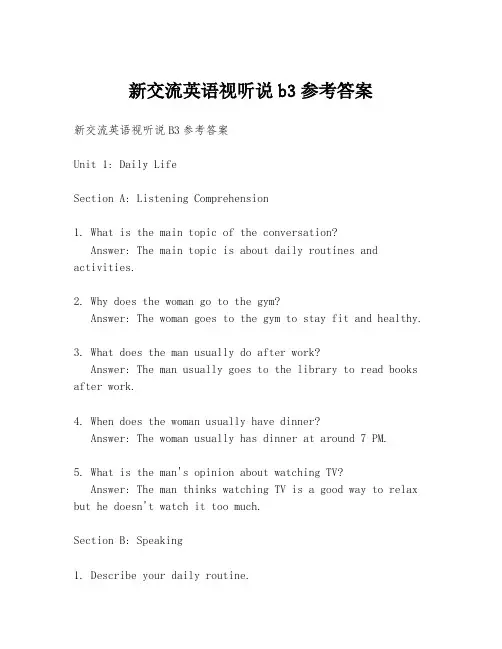
新交流英语视听说b3参考答案新交流英语视听说B3参考答案Unit 1: Daily LifeSection A: Listening Comprehension1. What is the main topic of the conversation?Answer: The main topic is about daily routines and activities.2. Why does the woman go to the gym?Answer: The woman goes to the gym to stay fit and healthy.3. What does the man usually do after work?Answer: The man usually goes to the library to read books after work.4. When does the woman usually have dinner?Answer: The woman usually has dinner at around 7 PM.5. What is the man's opinion about watching TV?Answer: The man thinks watching TV is a good way to relax but he doesn't watch it too much.Section B: Speaking1. Describe your daily routine.Answer: My daily routine starts with waking up at 6 AM, having breakfast, going to work, and returning home around 6 PM. I usually have dinner with my family and spend theevening either reading or watching TV.2. Do you think technology has changed the way we communicate? Answer: Yes, technology has significantly changed the way we communicate. We now rely more on digital communication methods like emails, social media, and instant messaging.3. How do you usually spend your weekends?Answer: On weekends, I like to spend time with my friends, go for a walk in the park, or sometimes just relax at home.Unit 2: Work and StudySection A: Listening Comprehension1. What is the man's occupation?Answer: The man is a software engineer.2. What does the woman do for a living?Answer: The woman is a teacher.3. Why does the man enjoy his job?Answer: The man enjoys his job because he likes solving complex problems and working with technology.4. What is the woman's opinion about her job?Answer: The woman finds her job rewarding because sheenjoys teaching and seeing her students learn and grow.5. How does the man plan to improve his skills?Answer: The man plans to attend workshops and take online courses to improve his skills.Section B: Speaking1. Discuss the importance of continuous learning in your field.Answer: Continuous learning is crucial in my field because technology is constantly evolving. To stay relevant, I need to update my knowledge and skills regularly.2. How do you handle stress at work?Answer: I handle stress at work by taking short breaks, practicing mindfulness, and maintaining a healthy work-life balance.3. What are some challenges you face in your studies?Answer: Some challenges I face in my studies include managing my time effectively, staying motivated, and keeping up with the workload.Unit 3: Travel and LeisureSection A: Listening Comprehension1. What is the main topic of the conversation?Answer: The main topic is about travel experiences and preferences.2. Where did the man go for his last vacation?Answer: The man went to Hawaii for his last vacation.3. What does the woman like to do when she travels?Answer: The woman likes to explore local cultures, try new foods, and take lots of photos.4. Why does the man prefer to travel alone?Answer: The man prefers to travel alone because he enjoys the freedom and flexibility it offers.5. What is the woman's opinion about group travel?Answer: The woman thinks group travel is fun and allowsfor shared experiences, but it can also be less flexible.Section B: Speaking1. Share your most memorable travel experience.Answer: My most memorable travel experience was visiting the Great Wall of China. The history and scale of the wall were awe-inspiring.2. What are some benefits of traveling?Answer: Traveling can broaden one's horizons, provide new perspectives, and create lasting memories.3. How do you plan your trips?Answer: I plan my trips by researching the destination, creating an itinerary, and setting a budget. I also make sure to include some free time for spontaneous activities.Unit 4: Current EventsSection A: Listening Comprehension1. What is the main topic of the news report?Answer: The main topic is a recent technological breakthrough.2. What is the significance of this breakthrough?Answer: The breakthrough is significant because it has the potential to revolutionize the industry and improve people's lives.3. How does the reporter describe the impact of this event? Answer: The reporter describes the impact as far-reaching and transformative.4. What are some of the challenges associated with this breakthrough?Answer: Some challenges include ethical considerations, regulatory hurdles, and potential job displacement.5. What is the public's reaction to this news?Answer: The public's reaction is mixed, with some expressing excitement and others expressing concern.Section B。
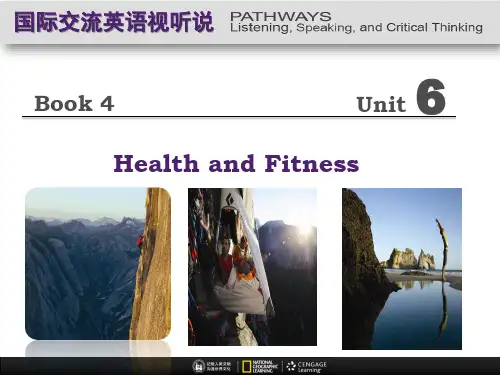
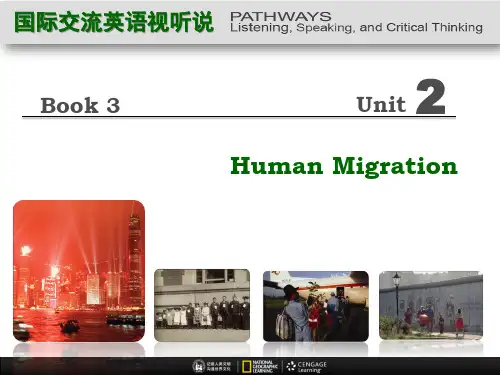
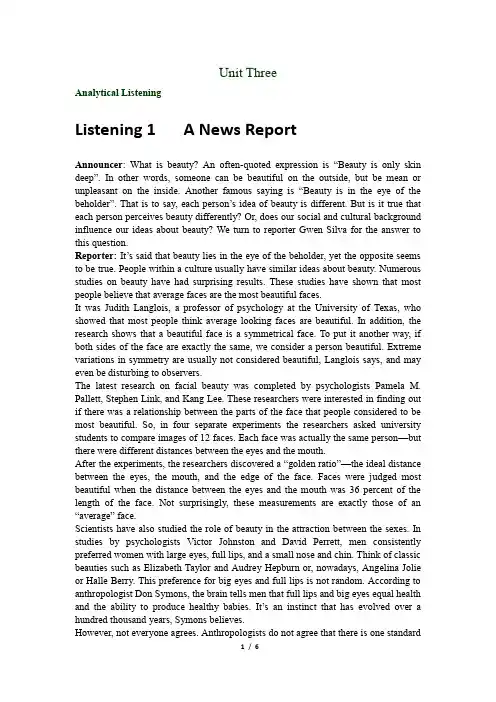
Unit ThreeAnalytical ListeningListening 1 A News ReportAnnouncer: What is beauty? An often-quoted expression is “Beauty is only skin deep”. In other words, someone can be beautiful on the outside, but be mean or unpleasant on the inside. Another famous saying is “Beauty is in the eye of the beholder”. That is to say, each person’s idea of beauty is different. But is it true that each person perceives beauty differently? Or, does our social and cultural background influence our ideas about beauty? We turn to reporter Gwen Silva for the answer to this question.Reporter: It’s said that beauty lies in the eye of the beholder, yet the opposite seems to be true. People within a culture usually have similar ideas about beauty. Numerous studies on beauty have had surprising results. These studies have shown that most people believe that average faces are the most beautiful faces.It was Judith Langlois, a professor of psychology at the University of Texas, who showed that most people think average looking faces are beautiful. In addition, the research shows that a beautiful face is a symmetrical face. To put it another way, if both sides of the face are exactly the same, we consider a person beautiful. Extreme variations in symmetry are usually not considered beautiful, Langlois says, and may even be disturbing to observers.The latest research on facial beauty was completed by psychologists Pamela M. Pallett, Stephen Link, and Kang Lee. These researchers were interested in finding out if there was a relationship between the parts of the face that people considered to be most beautiful. So, in four separate experiments the researchers asked university students to compare images of 12 faces. Each face was actually the same person—but there were different distances between the eyes and the mouth.After the experiments, the researchers discovered a “golden ratio”—the ideal distance between the eyes, the mouth, and the edge of the face. Faces were judged most beautiful when the distance between the eyes and the mouth was 36 percent of the length of the face. Not surprisingly, these measurements are exactly those of an “average” face.Scientists have also studied the role of beauty in the attraction between the sexes. In studies by psychologists Victor Johnston and David Perrett, men consistently preferred women with large eyes, full lips, and a small nose and chin. Think of classic beauties such as Elizabeth Taylor and Audrey Hepburn or, nowadays, Angelina Jolie or Halle Berry. This preference for big eyes and full lips is not random. According to anthropologist Don Symons, the brain tells men that full lips and big eyes equal health and the ability to produce healthy babies. It’s an instinct that has evolved over a hundred thousand years, Symons believes.However, not everyone agrees. Anthropologists do not agree that there is one standardidea of beauty. Around the world, different cultures have different ideas about what constitutes beauty. For example, the Mayan people of Central America considered crossed eyes beautiful. A number of African tribes think scars make both men and women more beautiful. Among the Maori people of Australia, a woman is considered most beautiful when her lips are tattooed blue.It does appear, therefore, that the old saying is wrong: Beauty does not lie in the eye of the beholder. Well, at least not entirely. People from the same culture usually envision beauty in the same way, but there are many variations—and many different types of beauty—around the world. This has been Gwen Silva, reporting. Listening 2 An Informal ConversationSandra: I’m so hungry. I hope the food comes soon.David: Me, too.Ana: I’m not so hungry yet, so I don’t mind waiting. Hey—by the way—I forgot to ask you about the fashion show. Dad, did you like it?David: Actually, yes. I’m really glad your mother convinced me to go. It was really interesting.Ana: And did you like it too, Mom?Sandra: I did. It certainly wasn’t a boring fashion show. The clothes were so imaginative, weren’t they?David: Yes.Sandra: That antigravity jacket was like a piece of science fiction.Ana: Antigravity jacket? What exactly is an antigravity jacket?David: I guess you could say it’s a balloon.Sandra: Right ... well, it’s part balloon, but it’s also part jacket. When the wearer takes it off, it just floats in mid-air like a balloon.Ana: That sounds cool!Sandra: Oh, it was. The designer, Alex Soza, said he gets his ideas from daydreams, and the antigravity jacket was just one of his daydreams.David: That jacket was interesting, I guess. But what amazed me was the vest made of Kevlar.Ana: Sorry, what does “Kevlar” mean?David: Well, Kevlar is a man-made fiber and they use it to make a cloth which is stronger than steel. You’ve probably heard of it before. Police officers wear Kevlar—or bullet-proof vests— sometimes to make sure they don’t get hurt if they are shot.Ana: Oh, that’s right. I know what you’re talking about now.Sandra: Kevlar is used in ropes, too—for astronauts in space.David: A model dressed as a police officer was walking a police dog, and the dog was wearing a Kevlar vest.Sandra: Oh, yeah. That dog was cute, wasn’t he?Ana: It’s amazing that Kevlar can actually stop bullets! It must be very strong. David: Oh, yes, it is. But it was developed back in the 1960s. These days they’re working on fibers that are considerably stronger.Ana: Really? Like what, for example?Sandra: Well, they said at the fashion show that spider silk is a natural fiber that is five times as strong as steel. And textile manufacturers would love to get a lot of spider silk at once, but it’s difficult to raise large groups of spiders together.Ana: Why?David: Umm, because spiders sometimes eat each other.Ana: Eww!Sandra: Instead, some scientists have found an interesting alternative. They call it BioStrong, don’t they?David: Actually, no, I think it’s called BioSteel.Sandra: Oh, that’s right. Scientists make BioSteel by inserting the spider-silk gene into goats. So, now the goats produce spider-silk protein in their milk, and scientists have derived a super strong fiber from the goat milk.Ana: That’s neat. What do they use it for?Sandra: They said that instead of using rockets to transport things into space, they envision that BioSteel will help pull things up to space and down again without having to use rockets.Ana: That’s really amazing.David: So, what did you do this weekend, Ana?Ana: Well, my friend was exhibiting some of her designs at an art gallery downtown, so I went there. She designs wearable electronics.Sandra: What do you mean by “wearable electronics”?Ana: Well, wearable electronics integrate clothes and electronics. She makes some really useful pieces—for example, a jacket with a cell phone right in the collar. My favorite item though was the GPS sneakers, um, sneakers with a global positioning system in them ... To allow parents to track lost children or rescue teams to track lost hikers.David: How innovative! And it sounds really useful, too.Ana: Oh, yes, definitely. Now, where’s our food? I’m starving.Viewing the WorldNarrator: In northwest Thailand, close to the Burmese border, lies a refugee camp. It harbors an unusual tribe. Stretched necks and collars made of brass rings define these women as Padaung. For centuries, the Padaung women have carried the tribe’s mark, the collar known as hcaung. But each of them began the painful process as a girl, when her bones were small and flexible. Even on the young, however, the coils are uncomfortable. To achieve the stretched-neck look of her elders, she’ll have to returnevery few years to have more coils added. The collar continues to hurt, but for Padaung girls, pain is a requirement of belonging. The long-neck look is actually an illusion.Manang: When you wear the rings, it is not your neck that gets longer. It is your shoulders that gets pushed down and lowered.Narrator: As the coil grows, its pressure pushes down on the shoulders and chest. The rib cage caves like a squeezed balloon and the neck appears to rise higher from the collapsed collar bones. The intentional deformation might seem cruel to outsiders, but to the Padaung, the hcaung is the signature mark of a tribeswoman. But the extreme practice that identified them as Padaung also marked them for persecution in their homeland of Burma, now called Myanmar.In 1962, the military took control of the country, promising modernization. The new leaders disapproved of tribes that were deemed primitive, and tribal customs, including the hcaung, were made illegal. To maintain their identity and escape civil war, Manang and others fled to the neighboring country of Thailand. Although safe from war, the tribe is now caught between two countries and two worlds. Narrator: Housed in refugee camps, the Padaung have drawn crowds of Western tourists, who travel here to witness the tribe’s ancient ways. Unexpectedly, what was once a persecuted mark of identity is now a profitable way to make a living. Today, Mabang will have the opportunity to find out how she’ll look without her brass collar. After 10 years, it’s time for the rings to be refitted. It will take close to an hour of pulling at the brass before the rings can be lifted from her shoulders.Mabang is astonished at how light she feels. She only speaks the Burmese dialect, so Maja helps her express her feelings.Maja: Well, we never get to see what the neck looks like, so we want to have a look and see how it turned out.Narrator: For outsiders, it’s incredible to imagine never seeing one’s own neck. For Mabang, it’s a transformative experience.Maja: She wants to dress up in regular clothes and let her hair down and see if she will look pretty.Narrator: As excited as she was to try on a new identity, Mabang eagerly returns to her old one, even though it may be years, even decades, before she sees her neck again.Maja: She says, this is our tradition, so it does not feel strange.Narrator: For Mabang, the embrace of coiled metal offers a passage back to who she is, not a restriction on who she might be. As refugees, the Padaung have endured much in order to preserve their culture, and their customs. Today, these rings of brass represent one tribe’s commitment to a future that does not sacrifice its past. Further Listening Listening 1In the world of high-fashion models, you don’t see the variations in body typethat you find with random people on the street. In fact, the classic runway model is skinny, or thin. Many people are disturbed by extremely thin models in fashion shows and magazines. Some models have a height-to-weight ratio that is unhealthy. For example, a model with an unhealthy height-to-weight ratio might be around 173 centimeters tall but weigh only 49 kilograms.The modeling business is slowly evolving, and the type of model that designers prefer is changing. In the past, fashion shows consistently featured extremely skinny models. Now, healthy-looking models are also appearing on runways. In some countries—Australia, for example—the government has even asked fashion designers and magazines to stop hiring extremely thin models for fashion shows and photo shoots. Now when designers think about presenting their clothes in a fashion show, they often envision their clothes on people with different body types. As a result, people’s perception of fashion models and their opinion of what constitutes beauty are starting to change.Listening 2Have you ever considered cosmetic surgery? The idea of changing one’s looks surgically disturbs or even frightens many people. Still, people’s feelings about cosmetic surgery have evolved over time. According the International Society of Aesthetic Plastic Surgery, more than eight million cosmetic surgeries were completed worldwide in 2009. The most popular type of cosmetic surgery was liposuction, a surgery where fat is removed from the body. Liposuction surgeries constitute about 19 percent of the total cosmetic surgeries in the world.Listening 3If you don’t already think clothing and textiles are amazing, here are a few examples that will convince you that they truly are.• The Cargolifter is a fabric balloon that is considerably taller than most balloons. It is nearly as tall as a 20-story building. It can carry up to 75 tons. It is used to transport trains from one place to another.• A design laboratory has developed an “intelligent apron” that can understand what you say and help you in the kitchen. Electronics and a microphone are integrated into the apron. The apron can turn on the stove, set a cooking timer, or show you a recipe on a screen.• New York City’s Museum of Modern Art recently exhibited a number of alternative items. One was “non-stop shoes”. These shoes collect the energy you create in the day, and in the evening you can insert an electric cord into them to poweryour electronic devices.。
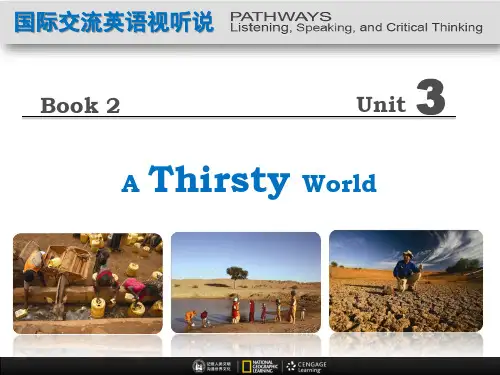
国际交流英语视听说3听力原文英文回答:This is an excellent question, as it demonstrates a strong interest in the complexities of international communication and the role that English plays in it. As such, I will do my best to provide a comprehensive response that delves into the various aspects of this topic.First and foremost, it is important to recognize that English has become the global lingua franca, meaning that it is the language that is most widely used for communication between people from different countries. This is due to a number of factors, including the historical spread of the British Empire, the rise of the United States as a global superpower, and the increasing interconnectedness of the world through trade and technology. As a result, English is now used in a wide variety of contexts, from business and diplomacy to education and entertainment.However, it is important to note that English is notthe only language that is used for international communication. In fact, there are many other languages that are also widely spoken around the world, such as Spanish, Mandarin, Arabic, and French. These languages are oftenused in specific regions or for specific purposes, and they can play an important role in facilitating communication between people from different cultures.In order to be effective in international communication, it is important to be able to speak and understand at least one other language in addition to English. This will allow you to communicate with a wider range of people and to participate more fully in the global community. There are many different ways to learn a new language, and there are many resources available to help you get started.In addition to language skills, there are a number of other factors that can contribute to effectiveinternational communication. These include cultural awareness, sensitivity, and empathy. It is important to beaware of the different cultural norms and values that exist around the world, and to be respectful of the ways in which other people communicate. It is also important to be sensitive to the different ways in which people may express themselves, and to be empathetic to the challenges thatthey may face.By developing your language skills, cultural awareness, and empathy, you can become more effective in communicating with people from different cultures. This will not onlyhelp you to build relationships and bridge cultural divides, but it will also help you to succeed in the global marketplace.中文回答:英语是国际交流的通用语言,在世界各地被广泛使用。
国际交流英语试听说B1U61. IntroductionIn this unit, we will focus on improving our listening and speaking skills in the context of international communication. We will learn key phrases and expressions that can be used in various situations, such as making introductions, asking for information, and expressing opinions.2. Listening SkillsListening is an essential skill in international communication. In this unit, we will develop our listening skills by practicing listening to different accents and understanding different speaking styles.2.1 Listening Activities•Activity 1: Understanding Different Accents–In this activity, we will listen to audio clips featuring speakers from different English-speakingcountries. We will be exposed to a variety of accentsand practice understanding them.•Activity 2: Identifying Main Ideas–In this activity, we will listen to a series of conversations and identify the main ideas or topicsdiscussed. This will help us improve our ability toextract key information from spoken English.3. Speaking SkillsSpeaking effectively is crucial in international communication. In this unit, we will focus on developing our speaking skills by practicing useful phrases and expressions that can be used in different situations.3.1 Speaking Activities•Activity 1: Making Introductions–In this activity, we will learn how to introduce ourselves and others in various formal and informalsettings. We will practice using appropriate greetings,introducing our name, and providing basicbackground information.•Activity 2: Asking for Information–In this activity, we will learn how to ask for information politely and effectively. We will practiceusing different question forms and techniques togather information from others.•Activity 3: Expressing Opinions–In this activity, we will learn how to express our opinions clearly and respectfully. We will practiceusing phrases and expressions to support ourarguments and persuade others.4. Cultural UnderstandingIn addition to developing our language ski lls, it’s important to understand the cultural aspects of international communication. In this unit, we will explore different cultural norms and practices that can influence communication styles.4.1 Cultural Activities•Activity 1: Cross-Cultural Communication–In this activity, we will learn about thedifferences in communication styles across cultures.We will explore topics such as direct versus indirectcommunication, nonverbal communication, andcultural。
国际交流视听说b1u6听力材料B1U6 International Exchange Listening MaterialSegment 1:A: Hi, Sara. I heard you just got back from studying abroad. How was your experience?B: Hi, John. Yes, it was unbelievable! I spent a semester in Spain and it was absolutely amazing. I had the opportunity to immerse myself in the Spanish culture and improve my language skills.A: That sounds incredible! How did you manage to communicate with the locals if your Spanish wasn't very strong?B: Well, at first it was a bit challenging, but I enrolled in a language course where I had the chance to practice with native speakers. I also made friends with some locals who were patient enough to help me improve.A: That's great! I'm glad to hear that you were able to overcome the language barrier. Did you face any other difficulties during your time abroad?B: Yes, definitely. One of the biggest challenges was being away from my family and friends back home. It was difficult not having them around for support. However, I made some amazing friends at the university who became my support system.A: That's wonderful. It's always great to have a support system,especially when you're far away from home. Did you have any memorable experiences while studying abroad?B: Oh, where do I even begin? I visited so many beautiful places in Spain, like Barcelona and Seville. I also had the chance to travel to other European countries during breaks. I loved exploring different cultures and trying new foods. It was truly a once-in-a-lifetime experience.Segment 2:A: Good morning, class. Today, we have a guest speaker, Mr. Li, who will be sharing his experience of studying abroad in the United States.B: Good morning, everyone. It's a pleasure to be here. I studied at a university in New York for two years, and it was a life-changing experience. Firstly, the academic environment was very different from what I was used to. The professors encouraged critical thinking and independent research, which greatly enhanced my learning experience.A: That sounds interesting. Did you face any challenges in terms of adapting to the American education system?B: Absolutely. The grading system was quite different, with more emphasis on assignments, exams, and class participation. It took me some time to adjust and understand the expectations. Additionally, the workload was heavier compared to what I was accustomed to in my home country.A: I can imagine that was quite a shift. Did you have any strategies to manage your workload effectively?B: Yes, time management became a crucial skill for me. I learned to prioritize my tasks and utilize resources such as study groups and office hours with professors. It helped me stay on top of my assignments and maintain a balanced lifestyle.A: That's fantastic. It's important to find a balance between academics and personal life. Did you have any opportunities to engage with the local community while studying abroad?B: Absolutely. I joined several student organizations on campus and volunteered in the local community. It allowed me to make friends, practice my English, and learn about American culture. I even had the opportunity to travel around the country during breaks, which was an added bonus.Segment 3:A: Hello, Linda. I heard you participated in a student exchange program recently. How was your experience?B: Hi, Mark. Yes, I spent a semester in Japan as part of a student exchange program. It was an incredible journey. The Japanese culture fascinated me, and I had the opportunity to learn about their traditions and customs firsthand.A: That sounds amazing. Did you face any challenges whileadapting to the Japanese culture?B: Oh, definitely. The cultural differences were quite significant. For instance, I had to adjust to their dining etiquette and learn to use chopsticks properly. Additionally, communication was a bit challenging initially, but I enrolled in a language course and practiced speaking with locals, which helped a lot.A: It's great to hear that you embraced the cultural differences and made an effort to learn the language. Did you have any unforgettable experiences during your time in Japan?B: Absolutely. One of the most memorable experiences was attending a traditional tea ceremony. The attention to detail and the peaceful atmosphere were truly mesmerizing. I also had the chance to visit famous landmarks and try delicious Japanese cuisine.A: That sounds incredible. Studying abroad seems like an enriching experience. Would you recommend it to others?B: Definitely. Studying abroad not only expands your academic knowledge but also broadens your horizons and helps you grow as a person. The exposure to different cultures, languages, and perspectives is invaluable. I would encourage everyone to consider this opportunity if they have the chance.In conclusion, international exchange programs offer students the opportunity to immerse themselves in different cultures, improve language skills, and gain a global perspective. While facing challenges such as language barriers, adapting to new academicsystems, and cultural differences, the overall experience is often rewarding and life-changing.。